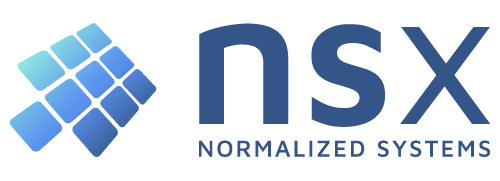
The NSX Software Factory
A Unified Command Center for Your Entire Software Landscape
In today’s dynamic digital environment, an enterprise doesn’t rely on a single application; it thrives on a complex ecosystem of interconnected software. While NSX provides powerful tools like the Micro Radiant and Expanders to build evolutionary software, the real challenge lies in managing and evolving your entire application portfolio.
From A Fragmented DevOps Landscape
The industry’s answer to managing the software lifecycle is DevOps, but this approach often relies on a complex, fragmented mix of different technologies and tools.
While all the data you need exists (in Git, Jira, Jenkins, SonarQube, or your cloud provider), integrated overviews and aggregations are not easily accessible. This fragmentation means your teams spend valuable time on manual, non-scalable tasks, creating a significant “lag time” for critical analysis, optimization, and improvements.
To A Unified Control Layer for Software Manufacturing
The NSX Software Factory is the first of its kind: a true integrated software manufacturing control system for your entire software landscape.
Similar to the MES (Manufacturing Execution Systems) and SCADA systems used to manage and control traditional manufacturing, the NSX Software Factory moves beyond a fragmented toolchain. It provides a single analysis platform and control layer to optimize your factory’s operations and output.
It works by automatically collecting, aggregating, and integrating information from your different DevOps tools. The result is a single, actionable view of your entire development lifecycle: Thanks to this unified view, you get the power to act on it by pushing security fixes, promoting new libraries, or identifying “weak links” in your application chains.
Key Features and Benefits
The Software Factory provides a unified data model to manage your entire landscape, from repositories and pipelines to applications and deployments. This integrated view unlocks powerful capabilities:
1. Monitor Key Metrics and Evolutions Over Time
A core function of a control system is tracking data over time. The Software Factory logs crucial metrics for all applications, allowing you to:
- Track history: Monitor the evolution of code quality, test coverage percentages, and build pipeline success rates, version over version.
- Gain deep insights: Understand how an application has changed. Is it accumulating more dependencies, more custom code, or more legacy? Or is it improving
2. Aggregate Quality Across Applications
Modern applications are not built in isolation; they are assembled by reusing multiple internal artifacts like libraries, domain components, and expander bundles. The Software Factory gives you:
- Instant, aggregated overviews: See the true quality and test coverage for a specific application by aggregating those metrics across all its dependencies.
- Identify “weak links”: Quickly identify the specific components in the assembly chain that are decreasing overall quality or introducing risk.
3. Track Technology and Resource Usage Across All Projects
Manage your entire inventory of internal and external software resources from a single dashboard. The system provides a centralized view to:
- Analyze vulnerability impact: Get an immediate overview of all applications impacted when a vulnerability is detected in an external library or technology.
- Standardize technology: Track all software libraries, artifacts, and frameworks used in your projects. Detect outdated dependencies or identify unfamiliar technologies that can be replaced by company standards.
4. Manage Deployment and Application Availability
The Software Factory provides the crucial link between your development lifecycle and your live operational environments. By integrating with your CI/CD pipelines and infrastructure platforms (like AWS, Azure, or on-premise), it provides a single, unified view of your entire deployment landscape.
- Gain a complete operational picture: Instantly see which application versions are running on which servers, in which environment (development, testing, production).
- Centralize application resources: Maintain a comprehensive, queryable list of all deployed applications and their associated resources, including server locations, databases, and credentials.
- Connect CI/CD to operations: Trace a live application instance directly back to the specific build pipeline and code commit that created it, simplifying troubleshooting and rollbacks.
Seamless Integration with the NSX Platform
The true power of the Prime Radiant shines when used in conjunction with the Micro Radiant
and Expanders. The NSX Software Factory offers extensive integration with the NSX platform.
- Manage Expander functionalities and their adoption rate across the organization.
- Propose and validate updated and approved Expander versions.
- Integrate code metrics and usage statistics directly into the Micro Radiant for immediate developer feedback.
Software Factories
Many organizations are striving to address their IT needs with a structured application landscape based on reusable building blocks. Others are trying to extend their IT landscape full of packages and services with reliable and mission critical custom development.
NSX tools and methodologies offer the productivity of code generation tools combined with the unique evolvability of NS applications during both development and the entire lifecycle. The evolvable nature of NS applications, including the unique feature of rejuvenation, enables these application landscapes to grow and adapt to the ever-changing technology landscape.

NS Competence Center
The Center for Application Development and Maintenance (B-CAO) of the Dutch Tax Office wants to be a reference in application development, building sustainable and easy to maintain applications for happy customers. Within this department, a Normalized Systems Competence Center (CCNS) has been set and grown over the last couple of years. Currently, the CCNS consists of 45 people and has delivered more than 10 applications into production.

NS Engines for ACPaaS
The Antwerp City Platform as a Service (ACPaaS) has been developed by Digipolis to collect and unlock digital services for the city of Antwerp and its inhabitants. ACPaaS contains a whole set of engines that can be consistently re-used to support the development of various data and application services, both in administrative domains and in an Internet of Things context. NSX has contributed to the development of numerous ACPaaS engines.
Normalized Systems eXploration
Find out more on how we can help you with a Normalized Systems eXploration.
